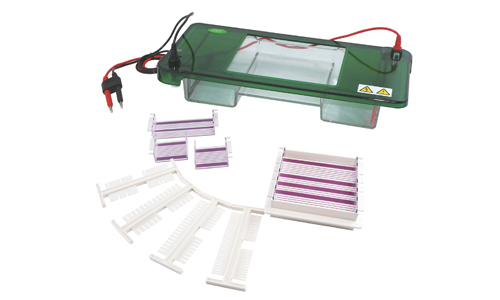Electrophoresis is an analytical technique in which a controlled electric current is used in order to separate biomolecules according to their size to electric charge ratio, using a gelatinous matrix as a base.
What rectives are used in electrophoresis?
Electrophoresis is carried out with equipment composed of a negative charge at one end and a positive charge at the other, called an electrophoresis system. In this technique reagents are used such as:
Loading buffer: It is a solution that is mixed with the sample before applying it to the gel. Its components serve several purposes:
In DNA electrophoresis: Glycerol to add density to the sample and facilitate its application to the wells. Bromophenol blue (or another dye such as xylene-cyanol) as a marker of the advance front of electrophoresis. Also, its color is a visual aid during sample loading into the wells. Buffer to stabilize the pH and, therefore, the charge of the molecules.
In SDS-PAGE protein electrophoresis, it is also called breaking buffer (since it causes denaturation): Glycerol to add density to the sample and facilitate its application to the wells. Bromophenol blue as a marker of the advancing front of electrophoresis. Also, its color is a visual aid during sample loading into the wells. SDS to cause protein denaturation (aided by brief heating to 90-100 ° C). β-mercaptoethanol to break disulfide bonds (a reduction reaction, the disulfide is converted to two thiols). Buffer to stabilize the pH and, therefore, the charge of the molecules.
- DNA agarose: It is a polysaccharide synthesized by some algae, which is part of agar-agar (an ingredient in culture media). For its use in electrophoresis a more purified product is used.
- Polyacrylamide: Polyacrylamide is a cross-linked polymer that forms porous gels. A chemical polymerization of a mixture of acrylamide and bisacrylamide [N, N’-methylene-bis (acrylamide)] is carried out.
- Ammonium persulfate DNA proteins: Although it is not a component of the gel, it is used as a reagent in the formation of polyacrylamide.
- TEMED: Tetramethylethylenediamine (TEMED) accelerates the polymerization reaction of acrylamide, as it propagates the generation of free radicals. Facilitates the reaction by which the acrylamide polymer is formed.
- Coomassie Blue: The full name is Coomassie R-250 Brilliant Blue. It is a colored compound that binds to all kinds of proteins.
- Bromophenol blue: This is a colored and charged compound used to check the progress of electrophoresis. In electrophoresis, due to its smaller size, it moves faster than proteins or most DNA molecules (those greater than 300 bp), that is, it marks the “advance front”.
- Xylene cyanol: These are colored and charged compounds used to check the progress of electrophoresis. In electrophoresis xylene-cyanol moves roughly like 3,500 to 5,000 bp DNA molecules.
- Ethidium bromide: It is an intercalating compound, that is, it has an affinity to bind to DNA, as it is introduced between its stacked bases. Its usefulness also derives from its fluorescence, enhanced by being in a hydrophobic environment, that is, by being bound to DNA. It is excited with short wave ultraviolet light, 254 nm, and emits its fluorescence as visible light, pinkish-orange in color.
At Kalstein we are MANUFACTURERS, we offer you excellent electrophoresis systems at the best PRICES. So we invite you to take a look: HERE

